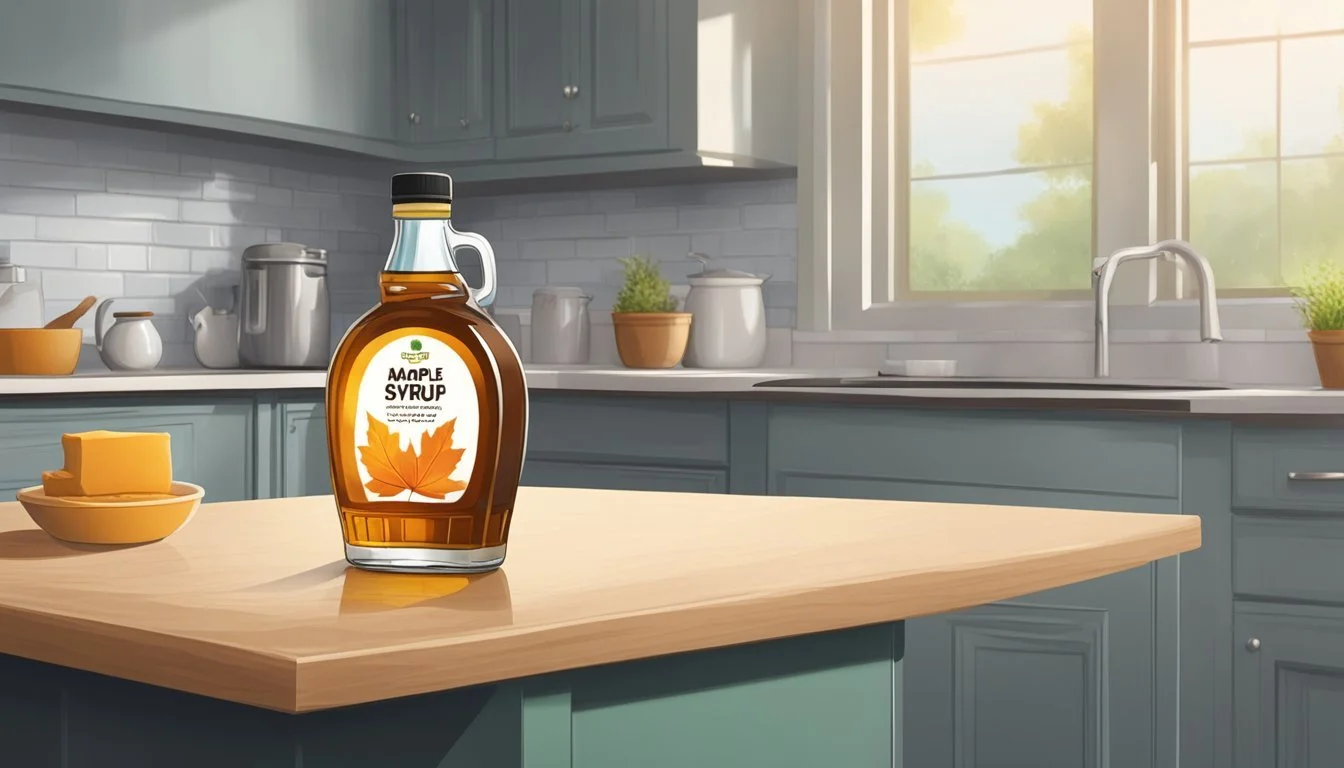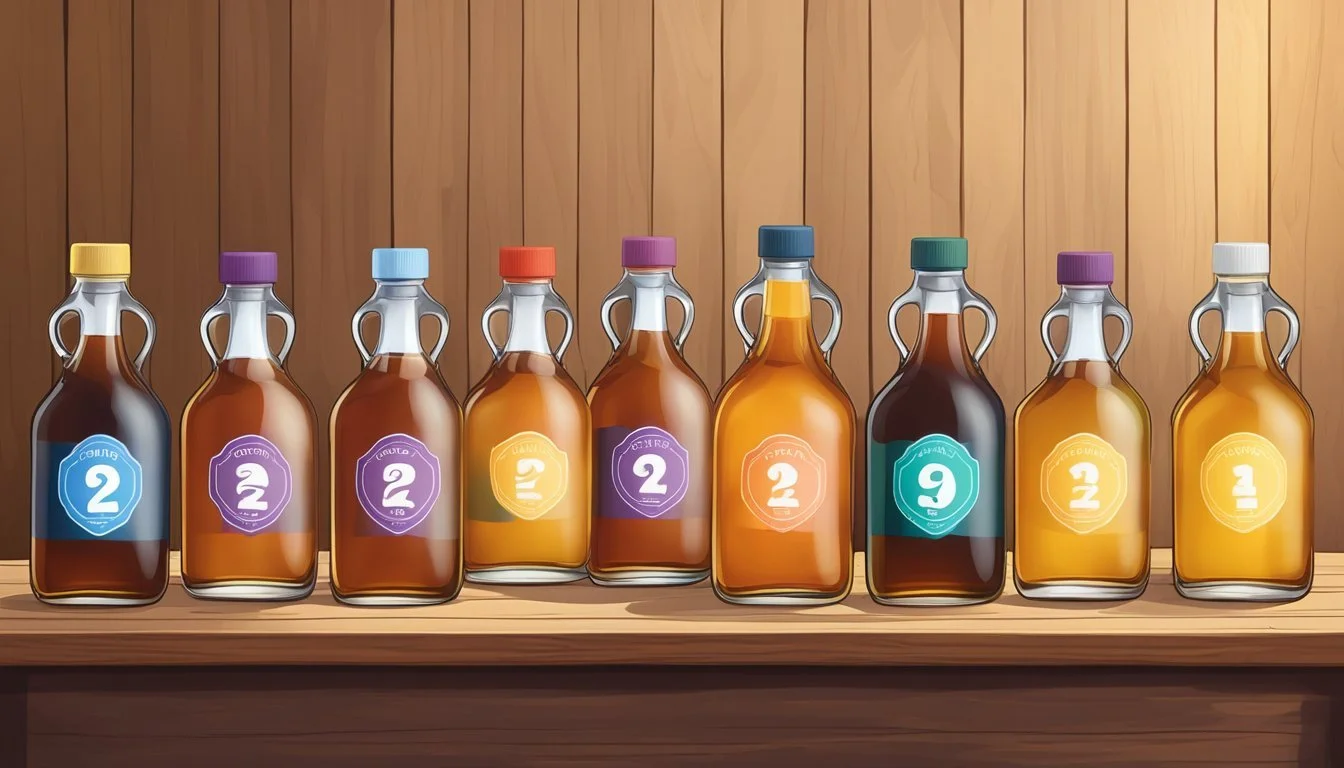Does Maple Syrup Go Bad?
Understanding Shelf Life and Storage Tips
Maple syrup, a natural sweetener derived from sugar maple trees, is a treat prized for its unique flavor and quality. It is most often a product with one ingredient—pure maple sap—boiled down to concentrate its sugars. The simplicity of its composition contributes to both its flavor profile and its storability. As a single-ingredient food, it does not contain preservatives that can extend shelf life, yet its high sugar content naturally slows down the degradation process.
Pure maple syrup’s longevity is a topic of discussion among both consumers and experts like the Vermont Maple Sugar Makers’ Association. When stored properly, an unopened bottle of maple syrup can last indefinitely, but once opened, it should be refrigerated to maintain its quality. Proper storage in a cool, dark place can help preserve its desirable characteristics.
Occasionally, maple syrup may develop mold on its surface when it’s exposed to air for extended periods. This mold is typically non-toxic, and the syrup can be salvaged by skimming off the mold, heating the syrup to kill any remaining microorganisms, and storing it in a clean container. The presence of mold doesn’t necessarily indicate that the maple syrup has gone bad, but rather that it's been stored under less-than-ideal conditions. It's essential to use sensory cues like odor and taste to determine its quality; any off flavors or smells signal that the syrup may have deteriorated and should not be consumed.
Assessing Maple Syrup Quality
When evaluating the quality of maple syrup, one should examine the color and flavor profile, as well as the texture and consistency. These characteristics are reliable indicators of maple syrup's purity and quality.
Color and Flavor Profile
The color of pure maple syrup ranges from a light golden hue to a deeper, darker brown, often referred to as caramel color. This variation is typically classified into grades which can influence the flavor of the syrup. They should expect a lighter syrup to have a more delicate, subtle taste, while darker syrup should have a stronger, more robust flavor that might hint at caramelization.
Grade A Golden Color, Delicate Taste: This is the lightest grade, with a mild, smooth maple flavor.
Grade A Amber Color, Rich Taste: A slightly darker syrup with a full-bodied maple flavor.
Grade A Dark Color, Robust Taste: Darker still, this syrup has a deep, rich flavor.
Grade A Very Dark, Strong Taste: The darkest grade, often used in cooking and baking for its intense maple flavor.
Texture and Consistency
Real maple syrup should possess a smooth, fluid texture without any signs of crystallization or sediment, which could indicate deterioration or impurity. The syrup should pour easily and coat the surface of foods without appearing watery or overly thick. If one does find any crystals in their maple syrup, this is often due to over-concentration or a reduction of water content, which can happen over time. They can gently warm the syrup to dissolve these crystals.
Shelf Life and Spoilage
Pure maple syrup is lauded for its longevity, yet it's not impervious to spoilage. Its shelf life varies depending on storage conditions and whether the syrup has been opened.
Factors Affecting Shelf Life
Several key factors determine the shelf life of maple syrup:
Storage temperature: Unopened maple syrup maintains quality for up to a year in the pantry and can last indefinitely when frozen. Once opened, it should be kept refrigerated and can be expected to last up to a year.
Seal integrity: An unbroken seal keeps maple syrup fresh for an extended period. Once opened, exposure to air can potentially introduce contaminants that may shorten its shelf life.
Presence of preservatives: Pure maple syrup typically lacks preservatives, which is why proper storage is crucial for maintaining its quality.
Container material: Maple syrup stored in glass jars tends to last longer compared to those in plastic, as glass is less permeable to air.
Signs of Spoilage
Recognizing when maple syrup has spoiled is straightforward:
Mold: If one observes fuzzy growths, typically white or blue-green, this is a clear indicator of mold on maple syrup. In many cases, surface mold can be removed and the syrup underneath still safely consumed after being heated to kill any remaining mold spores.
Odor: An off smell is a tell-tale sign that maple syrup may have gone bad. It should smell sweet and rich; any deviation could indicate spoilage.
Consistency: When syrup becomes excessively thick or crystallizes, it doesn't necessarily mean it's spoiled, but it may signal a degradation in quality. However, this can often be remedied by gentle heating to dissolve the crystals.
Consumers should regularly check their maple syrup for these signs of spoilage, especially after prolonged storage, to ensure that they are enjoying not just the flavor but also the safety of this natural sweetener.
Best Storage Practices
Effective storage of maple syrup ensures its longevity and preserves its quality. Whether unopened or after opening, specific conditions can help maintain the syrup's flavor and prevent spoilage.
Unopened Maple Syrup
Unopened maple syrup is best stored in a cool, dark place like a pantry. A constant temperature and lack of direct sunlight help prolong the shelf life indefinitely. Both glass jars and plastic containers are suitable for long-term storage, provided they are sealed well.
After Opening
Once opened, maple syrup should be kept in an airtight container in the refrigerator. This applies to syrup in glass or plastic containers alike. Refrigeration helps prevent the growth of mold and maintains the syrup's ideal flavor profile.
Freezing Maple Syrup
Maple syrup can also be stored in the freezer. Freezing extends its shelf life and is an excellent way to store large quantities. To freeze, one should use freezer-safe glass containers or plastic, leaving some space at the top for expansion. The syrup will not freeze solid due to its high sugar content, allowing for easy portioning.
Culinary Uses
Maple syrup's rich flavor and viscosity make it a sought-after commodity in the kitchen. It serves as both a complement to various dishes and a versatile substitute for other sweeteners.
Classic Pairings
In the culinary world, maple syrup most famously accompanies pancakes and waffles, creating a sweet and indulgent experience. These classic breakfast foods rely on the syrup's unique ability to soak into their fluffy texture, adding a burst of flavor in every bite. In addition to pancakes and waffles, maple syrup can enhance the taste of oatmeal, yogurt, and fresh fruit.
Versatile Sweetener
Maple syrup is a robust sweetener, often used as an alternative to honey, molasses, and corn syrup in a variety of recipes. It imparts a distinctive taste that works well in both sweet and savory dishes. Chefs often incorporate it as a sweetening agent in glazes, marinades, or dressings, which benefit from its complex flavor profile. Its natural sweetness also makes it a healthier substitute for processed pancake syrup in baking and dessert recipes, adding a subtle hint of maple to cookies, pies, and cakes.
Understanding Maple Syrup Varieties
When exploring maple syrup, it's crucial to understand the different grades that reflect color and flavor intensity, as well as the distinction between pure and artificial syrups.
Grades of Maple Syrup
Maple syrup is categorized into grades based on color and flavor profiles. These are determined by the sap's sugar content and the point during the tapping season when the sap is collected from the sugar maple trees.
Grade A Golden Color, Delicate Taste: This grade is light in color with a mild, delicate taste. It is often harvested at the beginning of the maple season.
Grade A Amber Color, Rich Taste: A bit darker, this syrup has a full-bodied flavor, suitable for pancakes and waffles.
Grade A Dark Color, Robust Taste: This darker syrup is harvested mid-season and is known for its strong maple flavor.
Grade A Very Dark, Strong Taste: Collected at the end of the season, this syrup has the strongest maple flavor and is often used in baking and cooking.
Pure vs. Artificial Syrups
Maple syrup can be either pure or artificial, with significant differences in taste, ingredients, and production methods.
Pure Maple Syrup: Made from the sap of sugar maple trees, pure maple syrup contains no additional ingredients. The sap is collected, boiled down, and filtered to produce real maple syrup with its natural flavor.
Artificial Syrups: Commonly referred to as pancake syrup, these are made from predominantly corn syrup and flavored with artificial maple extract. They do not come from the sap of maple trees and offer a distinctly different flavor profile compared to pure maple syrup.
Recognizing and Preventing Contamination
When it comes to preserving the quality of maple syrup, understanding the risks of bacterial and mold contamination is crucial. Proper storage techniques can significantly deter spoilage, ensuring the syrup remains safe for consumption.
Effects of Bacteria and Mold
Maple syrup is a stable sugar solution but can still be prone to contamination if not stored correctly. The presence of mold on maple syrup is a common issue, which typically appears as a floating layer on the syrup's surface. Although mold can often be removed by skimming and then heating the syrup, it is a sign of spoilage that can affect flavor and safety. Bacteria, on the other hand, are less visible but can also compromise the integrity of the syrup over time.
Preventive Measures
To prevent spoilage and extend the shelf life of maple syrup, several effective measures should be taken:
Airtight Containers: Always store syrup in an airtight container to minimize the exposure to air which can introduce spores and bacteria.
Refrigeration:
Unopened: Keep unopened maple syrup in a cool, dark place.
Opened: Once opened, refrigeration is necessary to retard mold growth and preserve the syrup's quality.
Regular Inspection: Check your syrup periodically for signs of mold. If mold is detected, the syrup can often be salvaged by bringing it to a slight boil, skimming off the mold, and transferring it to a clean, airtight container before refrigerating.
By adhering to these storage recommendations, maple syrup can remain a safe and delicious sweetener for a very long time.




